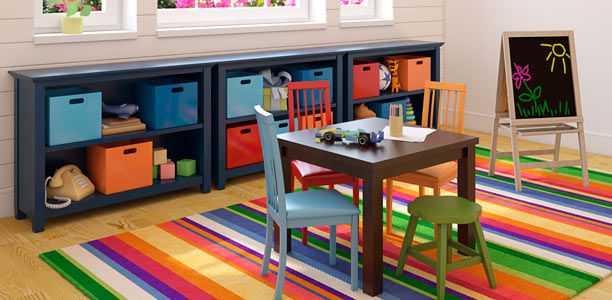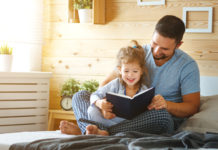Storage space is an important part of any child’s bedroom. Messy rooms and kids are seemingly inseparable. While you may need to do a bit more than create storage space to get your child to clean up, having plenty of space for them to hide their treasures is a good place to start.
Even if your child’s room is much smaller than you’d like, by using the space creatively you can create practical storage areas that your child will love to use.
Think about how you could use space that’s often left unused
1. Under the bed
Kids have a tendency to use the space under their bed to store dirty clothes and other things when cleaning up their room. Turning the area under the bed into storage space not only means there won’t be any space for them to hide their junk, it also means you’ll be putting a space that’s often unused to good use and creating extra space for storage. For toddlers and younger children, storing things under the bed is also practical, because they can open and close the drawers/containers themselves.
You can utilise the space under your child’s bed by:
- A bed with built-in drawers: This is a good option if you’re buying a new/pre-loved bed and can choose one with drawers, or if mum or dad just happen to be good with making things and can modify an existing bed to include pre-made drawers (available from your hardware store. Just measure the space under the bed and check out what pre-made drawers they would have that fit – these are normally used in cupboards – ask the staff for help and advice);
- Placing plastic storage boxes under the bed: Might be a more feasible option if you don’t want the trouble of making permanent drawers. Plastic boxes come in all shapes and sizes and with a bit of shopping you’re bound to find boxes that can slide under your child’s bed and out of sight. For younger kids, label the boxes (building blocks, dinosaurs, shoes, clothes, etc.) to help your child learn how to organise things and give them an opportunity to practice reading as they put away or take out their things.
- Another bed underneath: If you’re buying a bed you can look for a design that has a pull out bed underneath. This will be handy when your child start having friends sleep over and need a spare mattress (but don’t have anywhere to put it).
2. Above the door

A ledge or shelf above the door is an out of the way place, but the items you put there will still be on display (for example antique toys handed down from grandma that are a bit too delicate for everyday play). You could use it to store breakable items that are best kept out of kids way, or just about anything else your child would like to put there.
3. Behind the door
The back of the door is often out of sight. But it shouldn’t be out of mind when you’re thinking about creating storages spaces for your child’s bedroom. Let’s face it, no matter what their age kids have a tendency to leave mess on their bedroom floor. Attaching some large hooks to the back of the door so they can hang coats, hats or a dressing gown might help keep these off the floor.

The back of the door is also an ideal place to hang a towel rack or paint a chalkboard (using blackboard paint – attach a short ledge to put the chalk on or put it in small containers which hang off a rail).
4. In the corners
Corners are often fiddly spaces that are hard to use, but they’re the perfect place to fit small shelves which look unique. For example you could place shelves in that 50cm or so of wall between the corner and the window. Painted in a theme or contrasting colour, they can be used to brighten up a neutral wall. They’re also a great space to display books or trinkets that your child wants to show off.
Consider storage for different belongings, not just the really obvious things like clothes and toys
5. Little things need to be stored too
Cupboards and drawers are big enough that you’ll almost automatically consider them when planning your child’s room. But it’s often the little things that count, and when it comes to kids the little can make lots of mess, and are also the easiest to lose. If there are very young children around the house the little things can be extremely dangerous if they get swallowed. So it’s also a good idea to think about storage for little things when planning your child’s room.
6. Kids’ things sometimes need hiding
Remember that storage space is also used for hiding things. Whether it’s your pre-schooler’s half complete art project that you’ll finish tomorrow and don’t want lying on the floor in the meantime, or your teenagers love letter that you might accidently open if it’s left lying on the dresser, storage spaces that can keep things out of sight are important. For young children you might want boxes that you can quickly throw toys into to keep them in order (e.g. a box for blocks and another for dolls). These items won’t be hidden, but they make it easy to whisk things out of sight quickly.
As they grow up kids might want special boxes for storing prized items like pet rocks, pieces of jewellery or other trinkets. Teenagers who are going through puberty or passed puberty may need places to store items that they would rather their friends and/or family didn’t see, like their love letters, tampons or condoms.
A bit of creativity and imagination is also essential when it comes to creating storage spaces that are practical, and will make your child’s room look good
7. Hanging storage baskets
Let’s face it, there’s only so much you can do with the ceiling, but hanging storage baskets from it is one great, practical way to use the space in teenager’s rooms. They might not be appropriate for young children (who might just think ripping them down or using them as a swing is a whole lot better than watching pretty things hang in them), but for older kids and teenagers, there a practical way to create extra storage that looks good. And it can give that personal touch to a simple room. You can hang almost anything that’s not too heavy from a hook in the ceiling. Pot plants in hanging baskets can brighten up a room and give it creative flare. Hanging baskets are great for storing everything from personal belongings like toiletries to colouring pencils and other art supplies. The height can be adjusted as your child grows and depending on whether you want them to be able to reach the basket or not.
8. Shelve it
 Shelves can be made to any shape or size and are an excellent way to create storage space out of nooks and crannies that are too small to use for anything much else. It’s easy to construct a shelf yourself- just buy the brackets and bolts from a hardware store, attach them to the wall where you want your shelves to go, fix a flat piece of wood (you could use recycled planks or other wood to save money) on top. Slap on a coat of paint to match the theme colour of your child’s room and you’ll not only have a great storage space, you’ll also have a good looking room.
Shelves can be made to any shape or size and are an excellent way to create storage space out of nooks and crannies that are too small to use for anything much else. It’s easy to construct a shelf yourself- just buy the brackets and bolts from a hardware store, attach them to the wall where you want your shelves to go, fix a flat piece of wood (you could use recycled planks or other wood to save money) on top. Slap on a coat of paint to match the theme colour of your child’s room and you’ll not only have a great storage space, you’ll also have a good looking room.
Using skinny photo ledges up the wall to display books and puzzles is also a great way to decorate the room with your child’s personal favourites (somebody also put in a lot of effort into the artwork on those books – so make the most of it!). Having them on display also makes it more enticing for your child to pick up and read that book rather than if they just see the binding on the bookshelf.
9. Separate drawers into sections
Adding separators to your children’s drawers won’t make the storage space any bigger, but it’s an easy way to make drawers more organised and order uses the spaces you have better! For example, you can divide a single drawer into several compartments of various sizes for storing large and small items. Buy strips of thin plywood that you can cut up to make the separators at the hardware store. Cut it to size, sand off any rough bits if need be and glue it together with wood glue. You can slip it into the drawer and remove it later if your child’s storage needs a change.
10. Storage boxes
Storage boxes come in all shapes, sizes, colours and styles, and there a loads of relatively cheap options. There not only practical places to store all your child’s things, they can also be used to brighten up the room. You could buy or paint boxes in a theme colour, or if the contents might look attractive on display (e.g. colourful blocks) choose transparent ones.
If your daughter wants to be a soccer-star and your little boy is just crazy about dinosaurs, a storage box which captures your child’s interests might be just the encouragement they need to pack away their toys or crayons. You could spruce up an existing storage box using paints, stickers and other art supplies. Encourage your child to help you make the box (even if they’re young they can help with things like choosing stencils of stickers for the design)- they’ll take pride in displaying the finished product in their room because they know they’ve helped make it, (and they might just enjoy packing their toys away into the box).
11. Get hooked
Hooks can be attached to nooks and crannies that don’t have many practical uses. They’re very handy places to store school bags, jackets, hats and all sorts of other items that can be hung.
12. Bed on stilts
If you’re stuck with a small room (or even if you’re not), raising the bed off the floor and investing in a new/pre-loved loft bed means you can use the space underneath for another bed, book shelves, a desk, a cubby house, cupboard or drawers. It’s a great way to create extra space for storage.
 |
Find out more about bedroom makeovers for kids |



 (9 votes, average: 4.56 out of 5)
(9 votes, average: 4.56 out of 5) 






